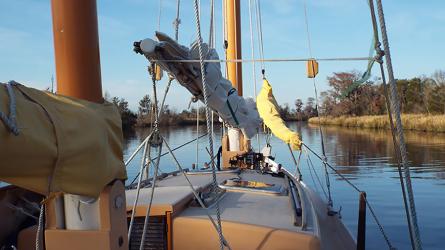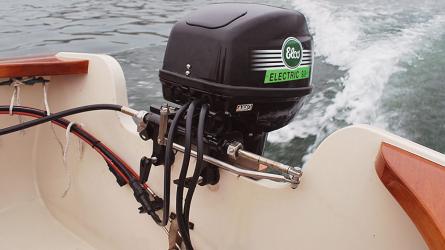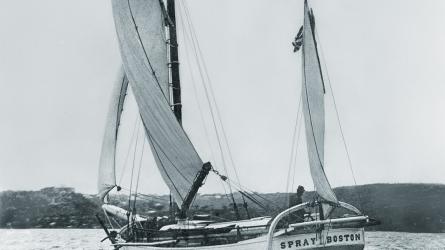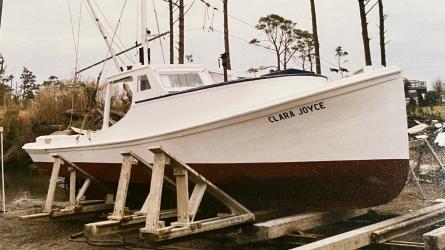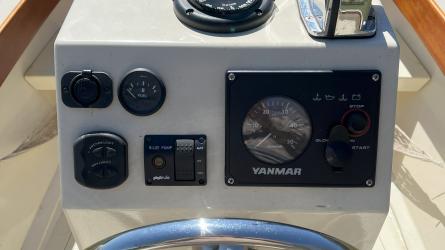Oar / Paddle
The Saturday Cove Skiff
A life at the oars began with a good boat
A life at the oars began with a good boat
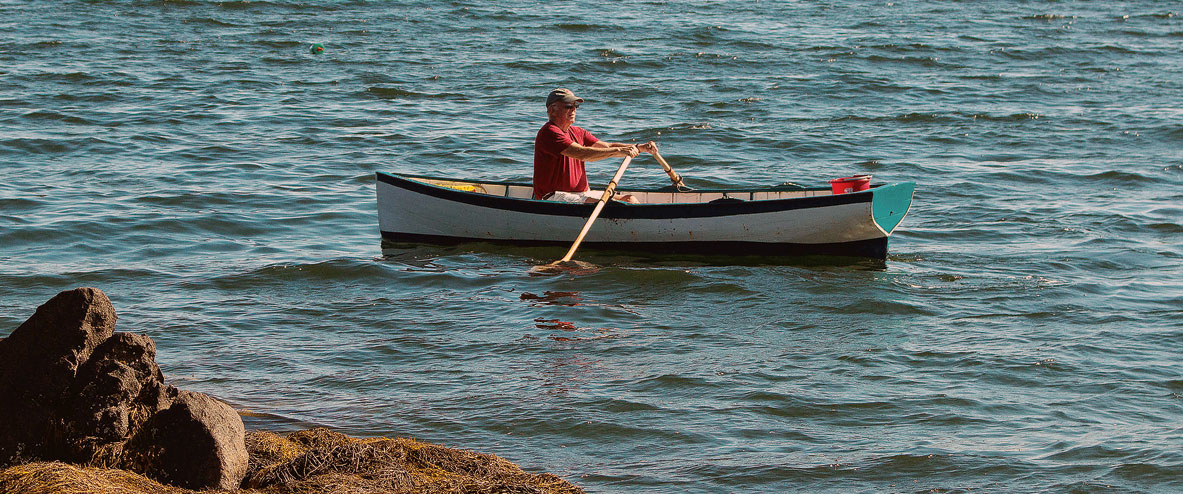
DIANE ALOSA-GRIEVES
Near Northport, Maine, the author rows his heirloom boat, now known as the Saturday Cove Skiff. The boat has been in his family since 1915, and he learned to row in it as a boy.
I’ve been a recreational rower, amateur grade, for most of my life. People have asked me why and how I came to enjoy rowing, and the answer is very simple: I’ve had a really good boat right from the start. I learned and practiced in a round-bottomed cedar-planked skiff along the western shore of Penobscot Bay in the Maine town of Northport, where my parents and grandparents had spent their summers at a place called Saturday Cove since about 1915. From about the age of seven or eight, I learned the feel of oarlocks, long leather-bound oars, and feathering.
My mother was a rower, too. She grew up with the same boat I did, and rowed it as a teenager, with friends, across the bay to Flat Island and Islesboro. Perhaps she went up to Belfast or down to Lincolnville Beach, too; the Northport area is all a big neighborhood, and early in the 20th century a rowboat was one of the better ways to get around in it.
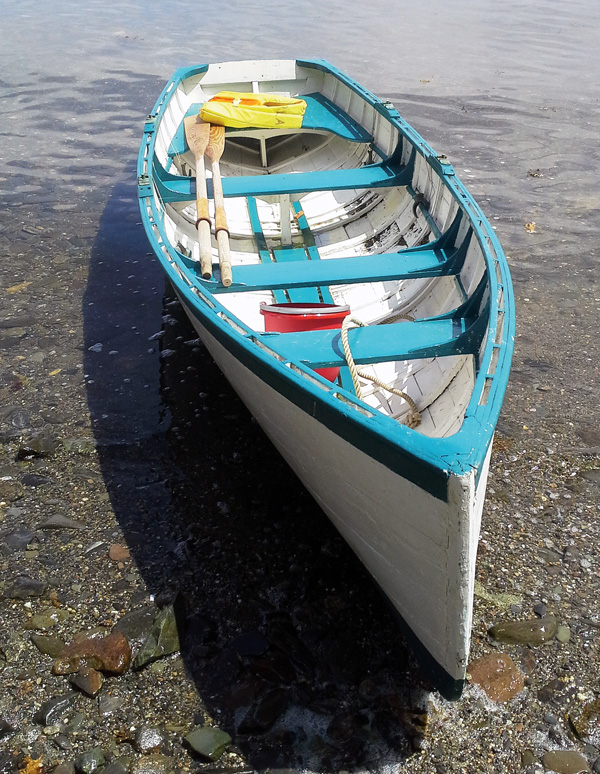
DAVID D. PLATT
The original Saturday Cove Skiff, as she appears today. The boat has been dragged over beaches for three generations, rebuilt several times, and maintained to varying standards.
Rowing isn’t like baseball or playing the piano. With only one lesson and a little time on your own, you can get the idea of it. From the perspective of about 60 years, a few thousand strokes, and more than a few stiff necks from looking over my shoulder to see where I’m going, I can now say that rowing came naturally to me not long after a nice older man named Fred, a Brit who worked as a caretaker for a number of summer families including my own, showed me the basics.
Fred had a Cockney accent and considerable patience. He had a way of swallowing his words, and while I can’t recall exactly what he said as I struggled with the oars, I can still hear him encouraging me: “harder on the right—[swallow]—ease ’er to the left a little—[gulp]— ’atta boy.” And along I rowed, eventually reaching the muddy beach where my mother was waiting with something nice to say about my skill. She would probably have instructed me herself but, subscribing to the driver-education wisdom of not passing along your own bad habits to your kids, she had asked Fred to help out.
The thing to remember about our boat—we call it the Saturday Cove Skiff because that’s where it first appeared in our lives, under our cottage next to the cove before World War I—is that it’s really easy to row. An inch or two over 13′ with a long keel, a slight hollow near the keel forward, with a nearly straight stem and a wineglass stern, the boat accelerates under oars faster than most. One stroke and you’re moving; two strokes and you’re probably at hull speed. Turns? Not too sharp! Stopping? Well, that takes a little time, because the boat is heavy enough to develop considerable momentum. Overall, as a boat in which to learn and appreciate rowing as a life skill, you can’t beat this one.
Rowboat design seems to have reached its zenith well over a century ago, when oar-powered boats were critical to harbor transportation. Wherries, gigs, Whitehalls, and similar craft plied sheltered waters all over the world, mostly moving people from point to point, much as taxis and other land-based vehicles do today. London, Boston, New York, and other harbors had their livery fleets, and the fastest of these were boats much like our skiff. The hull designs of racing shells, in fact, evolved from these boats as individual oarsmen and university crews began to compete.
Many of these boats, particularly those associated with expensive yachts, were fancy and sometimes trimmed in mahogany with bronze thwart knees, lifting rings, and other fittings. Ours is framed in oak and planked in cedar, has oak thwarts, and the thwart knees are made of grown apple crooks. There are no lifting rings. All of the original fastenings were iron, perhaps galvanized, though we’ve since replaced them with copper and bronze. It’s doubtful our boat came from Lawley or Herreshoff (both of which built tenders in quantity to high standards), but considerable skill clearly went into its construction. And while its oak sheer planks, stem, keel, thwarts, and transom make the boat heavier than others of its length, they’ve obviously contributed to its survival for well over a century.
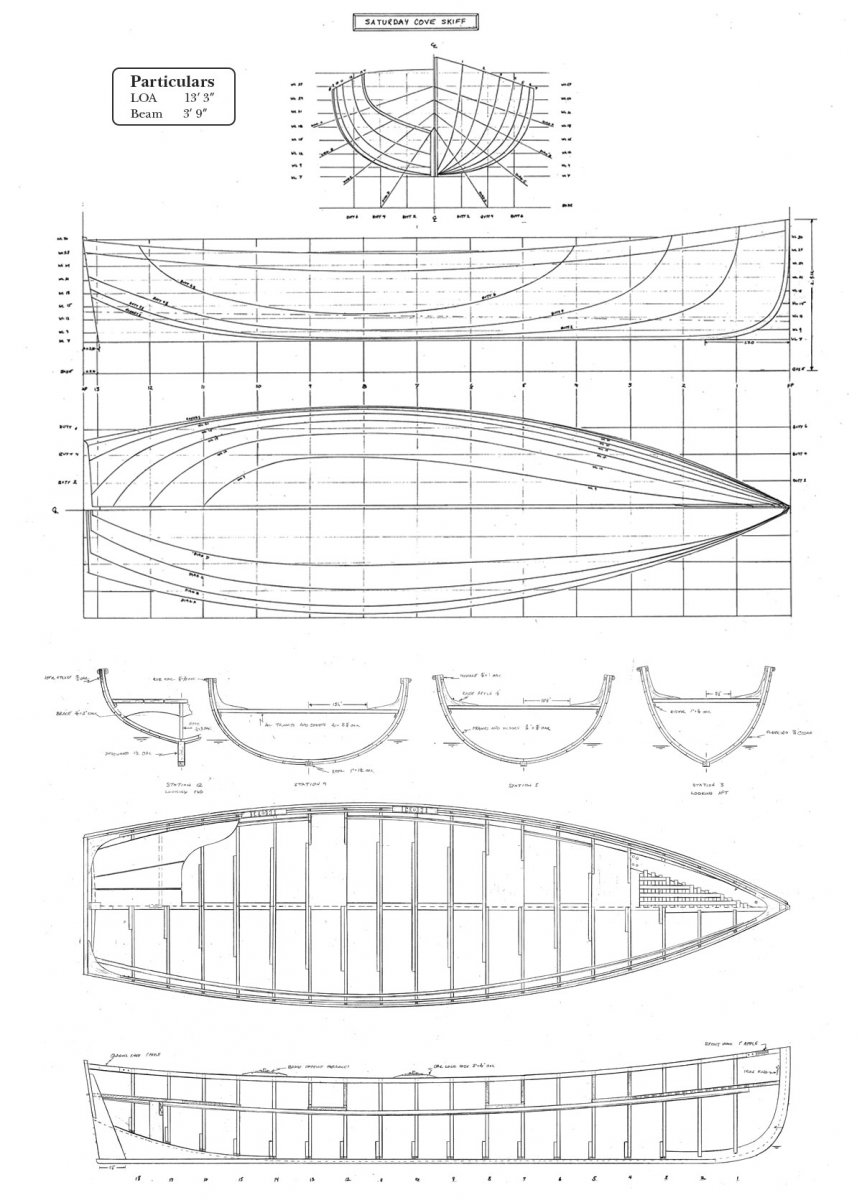
GREG RÖSSEL
Boatbuilder-author Greg Rössel recorded the shape and construction details of the Saturday Cove Skiff after rebuilding the boat for the author—and replacing the iron hull fastenings with new ones of copper and bronze.
All such boats represent compromises among a set of factors: waterline length, beam, stability, windage, and carrying capacity. A longer boat might require more effort by the oarsman but be faster once it gets going; narrow beam makes a hull faster but more tippy, or “tender”; high topsides might be drier but more affected by crosswinds; a small boat will carry fewer passengers and less dunnage than a big one. Then there’s the question of trim—weight distribution—which is why our rowboat has two sets of oarlocks. If you were brought up on movie epics featuring pirates or the British Navy, or have read Horatio Hornblower or Patrick O’Brian, you might assume that double oarlocks meant two oarsmen in striped shirts with a nattily uniformed officer steering at the stern. I carried that picture in my head for years. It’s incorrect, and it’s doubtful that two people together ever rowed our boat or any like her. The double oarlocks, at least in our small boat, are for trim. When rowing alone, you sit on the aft thwart and row from there; with a passenger at the stern, you man the oars from the forward position.
Maritime museum collections are rich in examples of these boats. Maritime historian and boatbuilder John Gardner includes a tender by George Lawley & Son in Volume 2 of his book, Building Classic Small Craft. It is similar to our skiff, although it is lapstrake-planked instead of carvel. The example he cites at Mystic Seaport is 12′2″ long with a beam of 4′3″; it has two rowing stations and a stem similar to ours. Its wineglass transom has the reverse curve of many such boats. Ours doesn’t have so refined a stern.
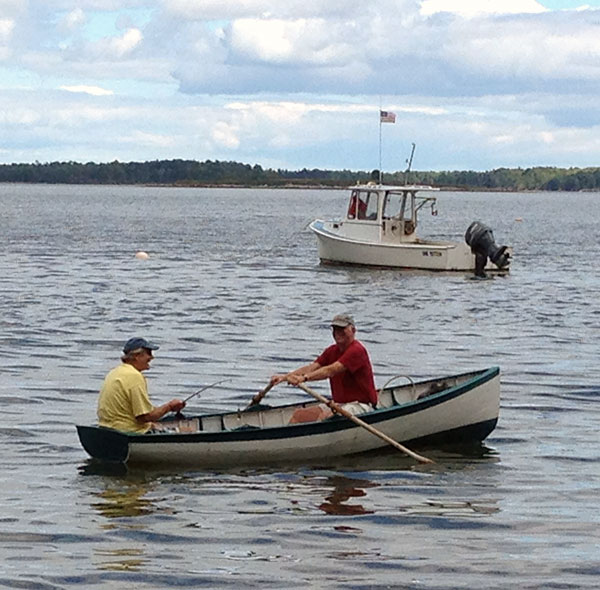
JANICE DRINAN
The skiff’s two rowing stations are not meant to accommodate two rowers. Rather, the forward station allows the weight of the oarsman to offset the weight of a passenger in the stern.
A second example at Mystic Seaport is carvel planked. “The clinker boat is definitely stronger and will stand more hard use,” Gardner wrote. Perhaps so, but our carvel version has lasted longer than the Mystic boat, which was built later, in the 1930s.
Maine Maritime Museum in Bath has plans in its collection for a 12′ Whitehall called HEROMA, with a stern like ours. The museum also has a 15-footer with two rowing stations and a reverse-curve wineglass transom. It’s called the Durgin Livery Boat.
All of these boats, and thousands of others like them, ferried passengers to and from docks and ships in harbors worldwide. Yet as Gardner points out, few of the original molds for them have survived. “Once a shop is shut down for good, molds and patterns are frequently thrown out, burned, or otherwise lost or destroyed,” Gardner observed, pointing out that in many cases the boats’ shapes had been carefully guarded secrets. In the Lawley shop “it is most unlikely that John Harvey [the master builder in charge there for many decades] would knowingly have permitted their removal…from the shop,” he wrote. Gardner reconstructed the lines of the tenders at Mystic from mold outlines copied years earlier by a Lawley employee. He later checked these outlines against measurements he took from actual boats at Mystic and found the mold shapes to be accurate.
The history of our rowboat isn’t particularly clear. For years we assumed it had been built somewhere in midcoast Maine by a local craftsman. But as the boat began to reveal itself under its many coats of paint, it became clear that this was no one-off workboat. Nor was it a Rangeley boat or other craft constructed for “sports” on the lakes of the North Woods. Now we think it must have begun life in a shop that turned out Whitehalls, wherries, skiffs, and other craft for harbor use. Whatever its origins, the boat was under our Saturday Cove summer cottage when my grandparents and a great-aunt and -uncle bought the place about 1915. The previous owners were from Philadelphia, which offers a clue. Someone called it a “captain’s gig”—another clue. It was once varnished inside, which suggests it was a pleasure boat from the start. The details—light, canoe-like construction with rivets, a long rabbetless keel, oak frames and sheer planks, a sophisticated grating forward, generous stern sheets, dual oarlocks, wineglass stern, provision for a rudder—all suggest construction to patterns and molds by a boatshop, rather than being a one-of-a-kind built in someone’s barn.
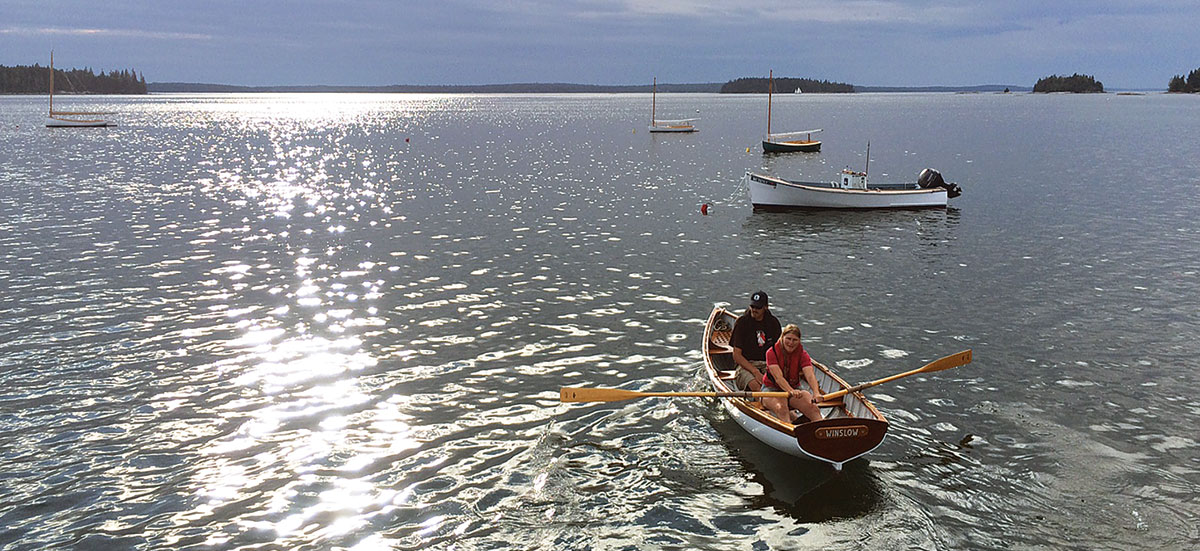
ANNE BRYANT
Here we see WINSLOW, a Saturday Cove Skiff built by students at WoodenBoat School under the direction of Greg Rössel. Occupying the two forward thwarts, her crew is experimenting with a rowing configuration different from the author’s prescribed arrangement.
Maine boatbuilder and WoodenBoat School instructor Greg Rössel wondered about the origins of this boat, which he called “cute” when I delivered it to him for one of its three rebuilds back in the 1970s. At the time it was in sorry shape: a couple of bottom planks were missing, many of its steam-bent oak frames were broken, its skeg was in danger of coming loose. The stem was cracked near its lower end. It had leaked for years even before those planks came loose, and the family—particularly my mother, the old rower—wondered if this boat had a future at all. When we loaded what could only be called a derelict into the back of my pickup truck for the run to Greg’s place in Troy, I remember telling my son, Josh, that if it broke in half on the way, we could always detour to the dump. Fortunately for all of us, it didn’t break and when Greg saw it, he, and we, knew we had something special.
I’ve often wondered why I took to rowing so early, particularly when friends tell me how much they prefer canoeing or kayaking, where you face forward and can see where you’re headed. They don’t get stiff necks, I admit, and there’s nothing wrong with going somewhere in a canoe; I’ve done it myself. But paddlers, even when they’re digging in to win a race or reach some goal, never experience the sheer power of the oarsman’s stroke, the springy lever of an oar powered by legs and back as well as arms and shoulders. And of course the paddlers, looking forward, miss out on the pleasure of seeing their wake.
I love history as well as rowing, and if you think of history as knowing where you’ve been, then rowing is history’s metaphorical twin. That line of bubbles behind your boat—straight, you hope, unless you’re dodging rocks, riverbanks, or other craft—tells you what you’ve just done. That kind of knowledge is invaluable in life, and seeing where you have deviated (or not) from your proper course always gives you an advantage as you move ahead, into the future.
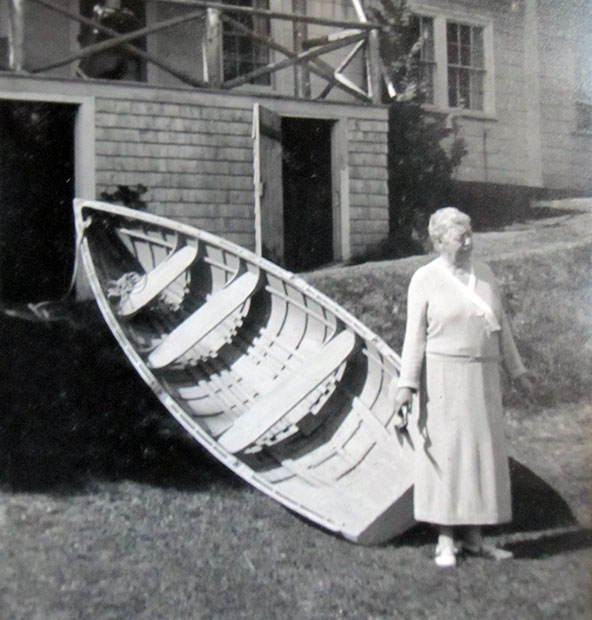
COURTESY OF THE AUTHOR
The author’s grandmother, Mame Day, stands with the family’s Saturday Cove Skiff in about 1930. She enjoyed fishing with her husband, who caught large flounder from the boat.
Our boat, like the examples at Mystic Seaport and Maine Maritime Museum, is very rounded in the bilges, and tender enough to dump an unsuspecting person into the cold waters of Penobscot Bay if they get too close to the gunwales. It’s not a boat from which to set a mooring or haul a trap, and it was never intended for an outboard motor, but it is definitely the boat to get you somewhere fast under your own power. At around 13′ it’s smaller than most Whitehalls. Our boat has endured a hundred summers of swelling up after a hundred winters of drying out. It has been rebuilt at least three times, repainted at least 50 times, and often not-so-lovingly cared for. It spends a few weeks most summers on an outhaul mooring not far from where I had that long-ago rowing lesson. Too many people have dragged its elderly bottom, too many times, up and down the gravel beach. Except for its fastenings and lower planks, which have been replaced along with some other parts, it endures.
During Greg Rössel’s ministrations 30 years ago at his shop, he took off our boat’s lines and created a detailed building plan that he sells today. From those same lines he made a half model that hangs today on my bedroom wall, a reminder that many of these boats were built from half models instead of plans.
Sometime after Greg took the lines and made the model, students at WoodenBoat School, under his supervision, built a new Saturday Cove Skiff that’s part of the school’s fleet today. I’ve rowed this boat, called WINSLOW, and it’s just as tender as our century-old skiff. The power and acceleration are the same, too. If a few more of these boats came into being, we’d have a fleet—a rowing one-design, and a very good one to boot.
We have a wonderful photo from about 1930 with the boat leaning against a bank outside the cottage, apparently awaiting launching so my grandfather could go out fishing. My grandmother stands next to it in her long dress—nothing elegant, just Mame Day on vacation in Maine. Perhaps she’d get to go out fishing with her husband, the judge, who (we know from another great old photo) caught some big flounder in Penobscot Bay that same summer. Judge Day died in 1933, ending the rowboat’s career as his fishing boat.
The family kept coming to Northport, and presumably launched the boat all through the 1930s and up to World War II when the Maine coast was, temporarily, not a favored vacation destination. If the cottage was used during the war years, the boat may have been launched; if not, it simply sat under the house. That was where I first encountered the boat around 1950, and since then, with time out for repairs and years when we didn’t use the cottage, it’s been a fixture in my life. I’ve had other boats, but the rowboat was where it all began.
Early on, I became a fairly proficient boat painter. Scraping, sanding, caulking, and other preparation came later, as they naturally would for a very young boat caretaker. It was more important to me, in those early years, to get the paint on and have the boat look salty and ready for the sea. Ready it wasn’t, of course, and the coats of paint piled up before I learned the wisdom of removing as much as I was adding each year. (I didn’t learn the importance of cotton caulking, structurally and leak-wise, until Greg Rössel explained all of that to me many years later during his course at WoodenBoat School.) In any event, the boat survived my efforts, gamely swelling to at least a moderately leaky state each year. What damage my inattention did to the boat’s iron fastenings would become clear when Greg did his rebuilding in the 1970s, by which time a complete refastening with copper rivets and bronze screws was long overdue. Suffice it to say that Greg saved our boat, and in the process he kept me at the oars.
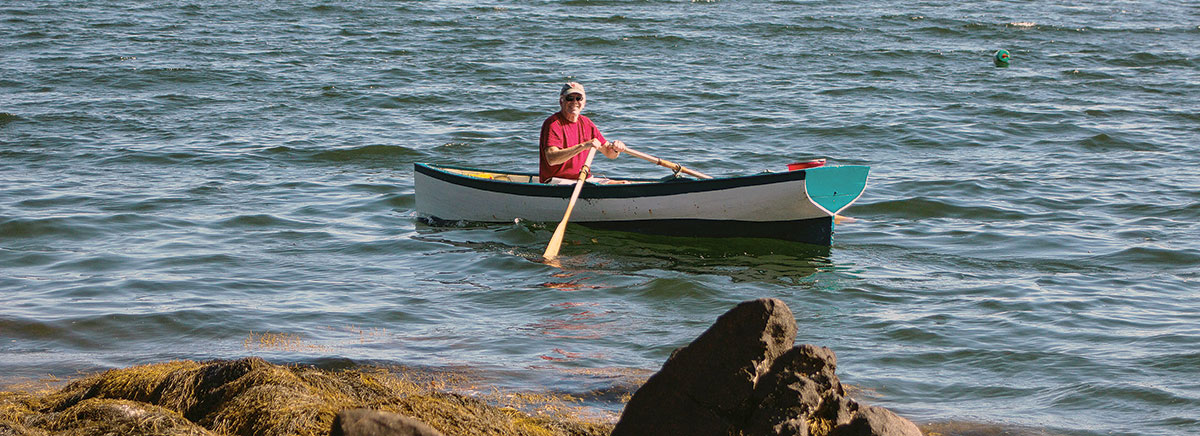
DIANE ALOSA-GRIEVES
“If you want to find out how bad rowing can be,” writes the author, “try a plastic dinghy, an inflatable, or a wide-sterned aluminum outboard. Any of them will make you think rowing is a futile pursuit.” The Saturday Cove Skiff, on the other hand, is a pure rowboat, and a delight.
Most people who row recreationally, of course, don’t share my experience with the Saturday Cove Skiff. The tenderness of a single scull or a racing shell may be new and even intimidating to them; certainly the sweet rowing capabilities of such boats—and our skiff—are unusual compared with most of the tubs that pass for rowboats these days. If you want to find out how bad rowing can be, try a plastic dinghy, an inflatable, or a wide-sterned aluminum outboard. Any of them will make you think rowing is a futile pursuit.
Early on an August morning when Penobscot Bay is calm, I haul the skiff (it has had many names over the years) in to the beach, walk to the water’s edge with the oars and life jacket, roll the boat up on its side to dump out the little water that has accumulated in its bilge, climb in, set up the bronze oarlocks and place the oars in them, untie the boat, push off, and row away. I head up the bay toward Belfast or down toward Lincolnville, depending on the direction of the tide. Two pulls at the oars and we’re moving well. My wake is straight and modest, reflecting my years of experience and the boat’s relatively small wetted surface. The bubbles trail behind, reminding me once again of the sheer pleasure to be found in a well-conceived rowboat. 
David D. Platt founded the monthly publication Working Waterfront for the Island Institute.
Plans for the Saturday Cove Skiff are available from Greg Rössel, 479 Bangor Rd., Troy, ME 04987.
